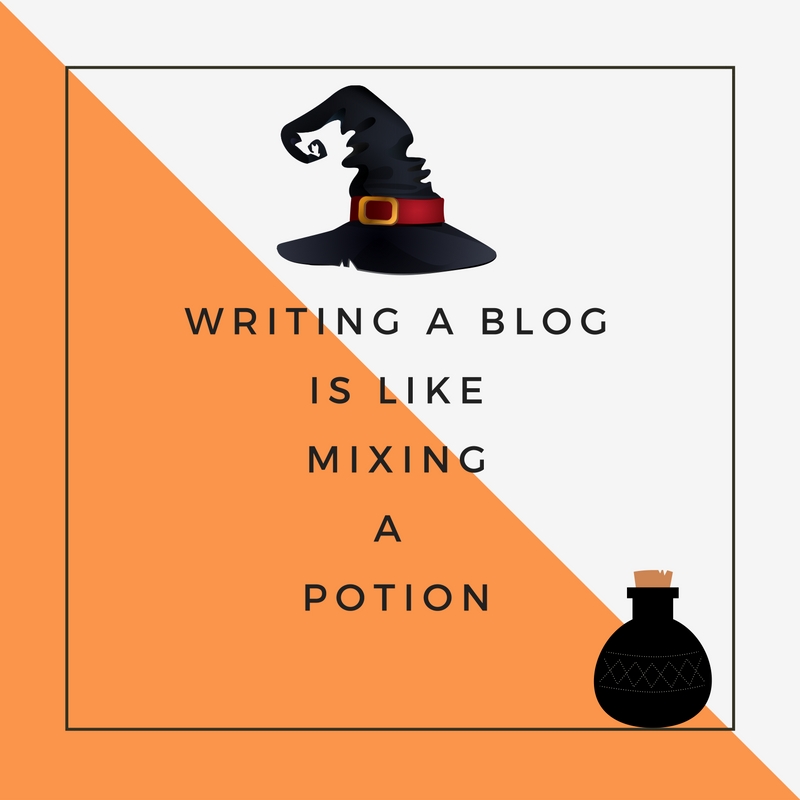The Magic of Writing a Great Blog Post

Writing a Great Blog Post is Like Mixing A Potion
The Magic of Writing a Great Blog Post
 You’ll have to forgive me: Pumpkin Spice has blown up, the weather is starting to get cooler (at least in the mornings) and I’m re-reading Harry Potter, so I’m on a bit of Fall/magic kick right now. But, if you’ve watched any magical movie or read any fantasy book I’m sure you’ll stick right with me on this one.
You’ll have to forgive me: Pumpkin Spice has blown up, the weather is starting to get cooler (at least in the mornings) and I’m re-reading Harry Potter, so I’m on a bit of Fall/magic kick right now. But, if you’ve watched any magical movie or read any fantasy book I’m sure you’ll stick right with me on this one.
In this blog post, I am breaking down, how to write a great blog post. Ironic right? Maybe not. With the advent of platforms like WordPress, Weebly, Wix and Blogger, it’s easier than ever to have a blog. But with this ease, comes competition. Now that it easier than ever to have a blog, everyone is doing it. In fact, everyone who wants to succeed on the internet will likely establish a blog because of the Search Engine Optimization (SEO) benefits.
Why do blogs help with SEO?
Google and other search engines want to see that you are putting out fresh content that is relevant to your readers. You can no longer just create a website and let it do the work for you. You need to refresh the content or create new content. Chances are that you put a lot of thought into the pages on your website, and injecting more on a frequent basis might blow up your well structured and easy to use site.
The blog becomes a way to add “pages” or posts without changing the layout of your site. Each post has all of the same SEO elements as a webpage so they cary the same value. This gives you the opportunity to write authoritatively on a number of different subjects that pertain to your brand, link to other posts and pages, and include photos. This helps people find what they are looking for, stay on your site longer and appear in additional searches, such as the Google Photo search option.
Think of the pieces that I talk about below, and the various bits of SEO as the ingredients to a complex but very useful potion…say the Polyjuice potion for my fellow harry potter fans. If you don’t have that perfect combination of ingredients mixed together in just the right way, you post will come out all wrong.
What goes into a great post?
Topic: Before you make a potion, you need to figure out just what you’re going to actually make, and why you want to make it. Writing a blog post is the same way. While search engines want you to have new content, it’s not enough to write content for the sake of writing new content. Your blog posts must have a utility or a meaning.
When you get the idea for a new blog post, take a moment to think “Does this speak to my audience?” Or “What persona would benefit from this?”. These types of questions will help you to make sure that you stay on topic and therefore stay relevant to your audience.
I almost got a little carried away with my hobbies on this blog and then I asked myself – will marketers and entrepreneurs care about this new pattern I wrote? And the answer was “Probably not” or at least, “not enough of them”. So I scampered back to BlueHost, purchased a new URL and created a space to talk about just that. It doesn’t have a place here so it doesn’t belong here.
Page Title: Think of this as the title of the potion, what would you look for if you were looking this up in a Hogwarts textbook? You want to get to the heart of what the potion is, what it does and why someone might need to use it. You don’t want to be too long or you lose people, and you don’t want it to be too short because you might not convey the right thing. Your Page Title is an important part of the SEO for your post. It should resonate in the URL, the Title and Subtitle, and be carried throughout the length of the post.
Title and Subtitle: After the Page Title, you are now into the body of the post. Once you flip to the page with the direction on how to make your potion, these are like the little notations written under the title. They give the reader, and the search engine a little bit more detail about what will follow.
Start the post with a clear title and sub title to let people and search engines know what the post is about. You’ll hear these referred to as your H1’s and H1’s sometimes, but that just means that they are the first and second “header” text in your post. You should only have one H1 and H1 in your post. Any other section titles that come after should be an H3 or smaller header text. Some people prefer to simply bold these additional sections.
Introduction: Provide an overview of the post and potentially some back ground information. Maybe you give the reason for writing this post, or why this topic is relevant or important to your audience. Keep this section nice and short. It should only be as long as it needs to be. Maybe you’re recounting an anecdote about why the potion was created, how it was derived or other relevant information about the potion.
The body of the Post: This should be thought of as the meat of your potion, the different steps required to make the potion. These should be sequential in order and clearly broken down. Just because you might be listing something like a recipe or creating a How To style blog post doesn’t mean that your post doesn’t have a natural order or flow to it. I’ve chosen to break this one down in a logical order, what you think of as you write a blog post.
Each point can have multiple paragraphs, and should have it’s own H3 or bolded sub-header. Keep in mind that not everyone likes to or is great at reading on the computer. It’s easy to get lost, so keep these paragraphs short. Keeping them short also allows people to skim the post for information that really speaks to them. This makes sure that you speak to even the busiest of your readers. Use bolded terms, bullet points and underlined text when appropriate to call out the important information and make it easier to read.
Photos: These are worth far more than just making your post pretty. Close your eyes and imagine a potions book, or a recipe book if that’s more your thing. There tend to be photos or sketches throughout each recipe. Photos help readers understand the content that are writing.
As we mentioned above, they help with your SEO. But now that I’ve told you that photos are important, you don’t want to slap just any old photo into your post. Not every photo that you use has to be taken by a professional photograph or be created by a designer. None of mine are. Stock photography also used to be a cheap way to get professional looking images, but readers have caught on and are trained to spot this type of imagery. I’m not saying never use stock imagery, but it does help to use it sparingly. All of my photos are either photos that I have taken myself, or an image that I created using a tool like Canva.
These photos should relate to the content that you are publishing. You can see a humorous way that I related photos of my niece dancing on the beach to my anecdote about starting my own business here.

